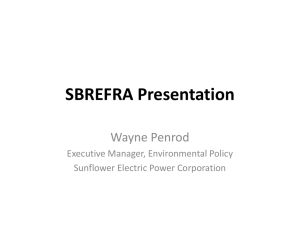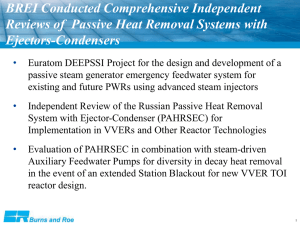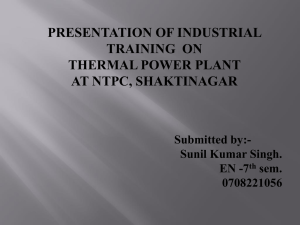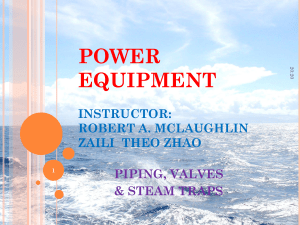制粒及其他热加工的蒸汽调制系统
advertisement
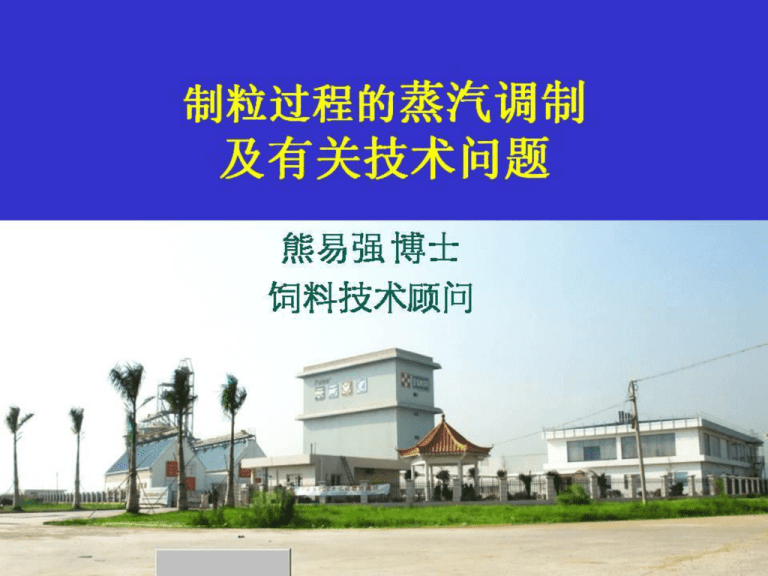
影响颗粒稳定度的因素
粉碎粒度
20%
调制
20%
环模
15%
配方/原料
40%
冷却
5%
蒸汽调制的关键
• 蒸汽质量:什么是蒸汽质量?如何得到
高质量蒸汽
• 根据饲料类型和调制时间长短正确设定
调制气压
• 原料与成品水分控制
蒸汽调制过程的热交换
• 蒸汽热量的组成:表观热与潜热
• 潜热---物料升温的主要热量来源:
–每凝结一个百分数单位的优质蒸汽,物料
温度大约上升 15 0C
• 蒸汽表
• 蒸汽质量
蒸汽表
压力
k g /cm
0.5
温度
2
0
C
表观热
over
潜热
- - - - k ca l/k g - -
总热
--
112
112
531
643
1.0
120
120
526
646
1.5
127
127
521
648
2.0
134
134
517
651
蒸汽质量
• 湿蒸汽-蒸汽中含液态水, 热量低,易堵
塞模孔
• 蒸汽质量可用气态水在蒸汽中的百分数来
表示
• 测定蒸汽质量的方法
• 过热蒸汽或不饱和蒸汽
• 判定过热蒸汽的方法
• 理想的蒸汽:100%饱和蒸汽
蒸汽质量的计算
蒸汽质量%
={[(W2xT2-W1xT1)/(W2-W1)-Hf]/Hfg}x100%
W1=注入蒸汽前水重
W2=注入蒸汽前水重
T1=注入蒸汽前水温
T2=注入蒸汽前水温
Hf=测试压力下的表观热(查蒸汽表)
Hfg=测试压力下的潜热(查蒸汽表)
蒸汽表
压力
k g /cm
0.5
温度
2
0
C
表观热
over
潜热
- - - - k ca l/k g - -
总热
--
112
112
531
643
1.0
120
120
526
646
1.5
127
127
521
648
2.0
134
134
517
651
蒸汽系统主要设备的选择与设定
• 锅炉
• 输汽管道内径的确定
•
•
•
•
汽水分离器
疏水阀
减压(稳压)器
流量控制阀
锅炉的选择与设置
Boiler Selection and Layout
• 燃料的选择要全面考虑供气稳定性、人工、燃料
价格及环境等因素
Fuel Type
• 锅炉的功率或供气量要留有余地
Boiler Size: Leave sufficient room
• 尽可能缩短锅炉与用汽设施之间的距离
Location of the boiler: close to the pellet mill
输汽管道内径的确定
Sizing the Pipe
ID (cm) = W x 3.53 v/30
W=蒸汽流量 (Steam flow),kg/min
v=给定气压下的比体积 (Specific volume
under given steam pressure),m3/kg (查
表)
30 = 最大流速 (allowed steam flow
velocity),m/s
气水分离器
Steam Separator
• 根据机械原理将蒸汽中的水滴与蒸气分
开以得到优质蒸汽.
Using a mechanical advice to remove water driplets from the steam and obtain high quality
steam.
• 好的气水分离器可移走98%的水滴.
Good separator can remove more than 98% of the
water drip-lets
疏水阀
Check Valve
• 其功能为将凝积水(在进入调制器前)从
蒸汽系统中排出.
To remove water condensate out of the steam
system (before the steam going into the
conditioner).
• 疏水阀应不时启闭使一定压力下的凝积
水移到常压的回收系统且不丢失蒸気.
It must periodically open and close to allow the
pressurized condensate to be removed in to an
atmospheric condensate return system without
losing steam.
减压(稳压)器
Steam Pressure Reducer-Regulator
• 只有气压稳定才能使气流稳定,从而保证制粒过
程稳定. Steady pressure is critical for smooth steam
flow and hence smooth pelleting operation.
• 减压有助于提高蒸汽质量.
Pressure reduction helps improving steam quality.
• 减压(稳压)器的主要参数:流量、调压范围及控
制的稳定性(可用变异系数度量).
Parameters for consideration: Maximum flow (kg/hour),
pressure range, pressure stability (expressed as CV%).
流量控制阀
Steam Flow Control Valve
• 控制进入调制器的蒸汽流量.只有物料流量与蒸
汽流量同步控制才能实现稳定的制粒作业.
It meters the steam flow going into the conditioning
chamber- an important device for operator
• 调制器操作与流量应是线性关系.
A linear response is required between control valve and
steam flow.
• 一般的控制阀的操作与实际流量不是线性关系.
The gate valve is non-linear - at half opening, small
changes in setting results large steam flow variation.
Cospect Valve
• 减压、分水、气压控制三合一
A separator - trap - pressure regulator “three in
one”device.
• 流量控制阀在自动和手动控制条件下均与
流量呈线性关系.
Linear steam flow control valves for both manual
and automatic control system
-
蒸汽调制系统参数的设定
Parameter Settings in Steam Conditioning
• 考虑因素:调制时间、蒸汽质量、饲料配方.
Factors to be considered: Retention time, steam quality
and formulation/ingredients.
• 对于一般饲料配方,应在不塞机的前提下,尽
可能提高料温.
In general, mash temperature should be conditioned “as
high as possible” before reaching the “chock point”.
减压前后的压力比
Pressure Ratio before –after Pressure Reducing Valve
- 减压可使蒸汽中的水滴挥发. 减压幅度过大,在蒸
汽质量好时,可形成过热 (不饱和)蒸汽.
Pressure reduction helps water drip lets flash off but may
also produce a supper-heated steam if the pressure drop is
too much and the steam quality already very high.
• 一般推荐: 3.5-4:1
General Recommendation: 3-4 to 1
进入调制室的蒸汽压力设定
Steam Pressure Setting before Conditioner
• 调制时间短,蒸汽质量好,宜采用低蒸汽压
(1.5 -0.5 kg /cm2 或 更 低), 以争取热
交换时间(并降低能耗).
Low pressure (0.5-1.5 kg/cm2) is preferred if retention
time is short (20 sec or less).
• 调制时间长,可采用较高蒸汽压力。
Higher pressure works well (2-4 kg/cm2) if retention
time is long (40 sec or more).
• 关键在于有足够时间完成热交换-释放潜热.
The key is to give sufficient time for heat transfer releasing latent heat.
高乳清粉乳猪料蒸汽参数的设定
Steam Setting for High Whey Diet
• 调制温度≤700C 以控制水分避免塞机
Keep mash temperature≤700C to avoid moisture
increase caused stickiness
• 可考虑采用较高蒸汽压力甚至过热蒸汽
Higher steam pressure - low steam flow, or
supper heated steam may help
蒸汽调制时间
Retention Time
• 延长调制时间有助于水分进入并软化粉料以提
高颗粒质量
Extended retention time helps moisture penetration and
softens particles for better pellets.
• 调制时间测定(Measuring mean retention time):
MRT (Sec.) = (3600xW)/(1000xP) where,
W = 调制器内水分校正的物料量, kg
Moisture adjusted mash weight in conditioner, kg
P = 产量, MT/h
Production rate, MT/h
蒸汽调制时间
Retention Time
• 延长常规调制器调制时间的简易办法: 通过调节
浆片角度提高物料在调制器内的充满度.
Extending Retention Time by Adjusting Pitch Angle
• 夹层(间接)蒸器的作用
The role of indirect steam .
Extending Retention Time
by Adjusting Pitch Angle
• Mash fill before adjustment
•thermomet
er
Conditioner Paddle Pitch
Adjustment (Top View)
Mash Fill after Adjustment
延长调制时间的设备
• 多层调制器
• 可变仰角调制器
• 熟化调制器
Ripenner
• DDC
制粒过程的自动控制
• 料流控制
• 蒸汽流控制
• 料温反馈控制,电流反馈控制
常规蒸汽调制的局限性
Limits to Traditional Steam Conditioning
• 高水分、低温原料限制料温升高。
Can not achieve high mash temperature when ingredient
moisture is high and temperature is low.
• 解决途径:烘干-预热?投入机械能? 加压调
制?
Solution: Drying ? Pre-heating ? Mechanical energy
input ? Pressurizing?
What’s New ?
- For Better Pellets -
制粒工艺过程的水分控制
控制关键点
• 调制前粉料水分: 水分低于12%在混合物机
加水(一般不超过一个百分点)
• 调制后水分可通过料温上升估测
• 成品水分: 通过冷却时间-料层高度调节
关键设备
• 以电容为基础的快速水分测定器:
–不需样品粉碎
–不需称量
–测定误差不超过0.5百分数单位
–手工操作系统,六秒中得结果,电脑自
动监测系统,每秒20个以上读数
制粒问题解难案例
Pelleting Trouble Shooting- Case by Case Analyses
例 1(广东,1985)
Case 1 (Guangdong)
• 问题: 产量偏低,爱环镆寿命低
Problem: low production rate., die wearing to fast
• 现场观察: 进入调制器蒸汽压: 2.7kg/cm2,
On-site observation: Steam pressure at conditioner 2.7
kg/cm2
• 问题所在?如何解决?
Solution?
例 2 (美国,1990)
Case 2 (US-1990)
• 问题: 兔颗粒质量差,含粉多.
Problem: poor pellet
quality in a rabbit diet.
• 现场观察: 未发现明显异常. 与工人座谈得知唯
一改变是粉碎玉米由厂外带加工.
No significant problem found in pelleting operation. Only
changes recently made was corn meal supplied from tollmilling by an outside contractor.
• 问题所在?如何解决?
Solution?
例 3 (美国,1994)
Case 3 (US-1994)
• 问题: 料温上不去,颗粒质量差,含粉多,产量低
Problem: Low mash temperature, poor pellet quality, low
production rate.
• 现场观察: 给汽打滑, 减压前-后蒸汽压: 6.5-2.7,
手可握住疏水阀后水管.
On site observation: surging when adding steam; steam
pressure at boiler: 6.5 kg/cm, after conditioner: 2.7 kg;
hands can hold on pipe after check valve.
• 问题所在?如何解决?
Solution?
例 4 (江西,1999)
Case 2 (JiangXi-1999)
• 问题: 成品水分. 10.5%.
Problem: Low mash temperature, poor pellet
quality, low production rate.
• 问题所在?如何解决?
Solution?
例 5 (深圳,1999)
Case 5 (Shenzhen-1999)
• 问题: 乳猪料(含乳清粉), 制粒困难.
• 问题所在?如何解决?
Solution?
THANK YOU!
熊易强
更多的信息请进入
中国饲料行业论坛
www.feedmill.org.cn

